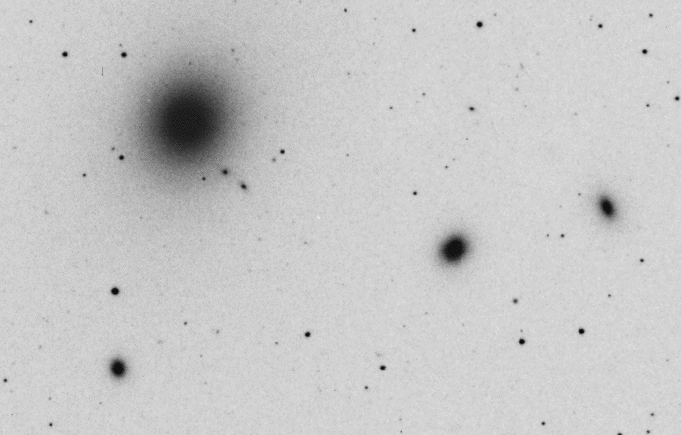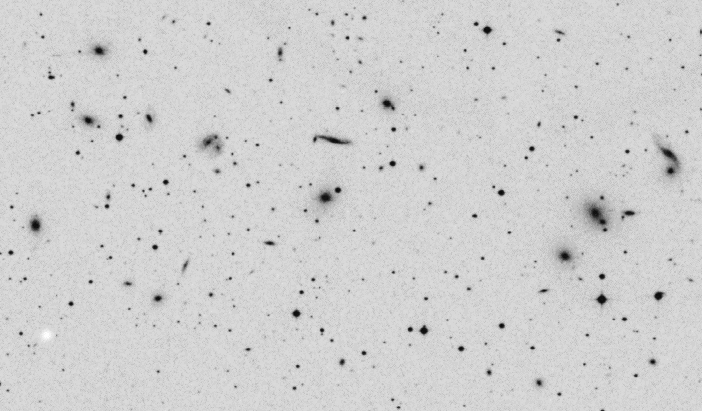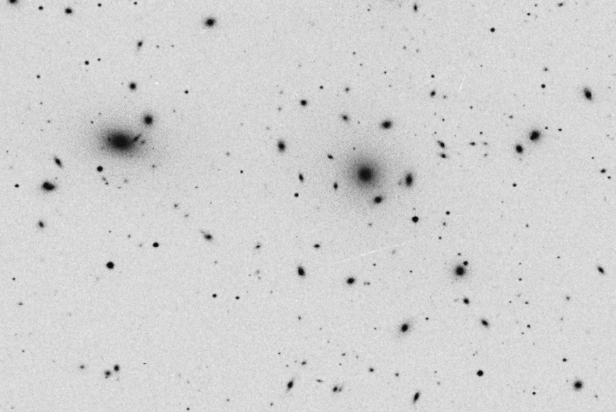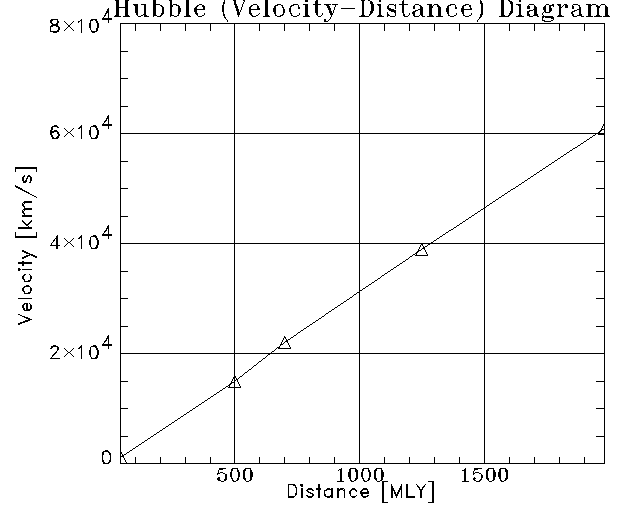
Name: ________________________
Student Number: ______________
1. (5 pts) Distances to Clusters of Galaxies



(i) Place the three above clusters in order based on how far away they are from the Milky Way.
A C B
closest middle farthest
(ii) Explain on what galaxy cluster characteristics you made this decision.
(i) Sizes of the galaxies -- galaxies appear larger if closer
(ii) How many galaxies are visible in the image -- can see more in field
of view if farther away.
(iii) Distances between galaxies -- the farther apart they appear to
be the closer they are, if their actual distance is similar
2. Velocity - Distance Plot
(i) (3 pts) Plot the data from the table below to make a velocity-distance,
Hubble Diagram for galaxy clusters.
Galaxy Cluster Velocity Distance
(km/sec) (Million LY)
Virgo 1,200 39
Ursa Major 15,000 500
Corona Borealis 22,000 700
Bootes 39,000 1,250
Hydra 61,000 1,980

H = V/D = 30.7, 30.0, 31.4, 31.2, 30.8 km/s/MLY
Average: H = average V/D = 30.8 km/s/MLY
(iii) (5 pts) From H calculate the age of the universe.
If (in our mind) we reverse the outward expansion of all the galaxy
clusters and "run the movie backwards," we can determine the age of the
Universe as the time when all these galaxies were in the same place.
From Hubble's Law and the relation
between velocity, distance and time, V=D/t or D=Vt, determine the time
it took for the galaxies to get to where they are now. This is the
maximum age of the universe. Derive the algebraic expression for this
age of the universe, and then calculate the universe's age (in billions
of years) (1 year = 3.14 x 107 sec).
V = HD = D/t
so time to reach a separation D going at velocity V is
t = D/V = 1/H
Must be careful of units. The easiest way is to convert the distances of the clusters from MLY to km
1 LY = 9.5x1012 km, so 1 MLY = 9.5x1018 km
Galaxy Cluster Velocity Distance Distance
(km/sec) (MLY) (km)
Virgo 1,200 39 3.71x1020
Ursa Major 15,000 500 4.75x1021
Corona Borealis 22,000 700 6.65x1021
Bootes 39,000 1,250 1.19x1022
Hydra 61,000 1,980 1.88x1022
Then from D = V*t get t = D/V:
t (Virgo) = 3.71x1020 / 1,200 = 3.09x1017 sec
t (Ursa Maj) = 4.75x1021 / 15,000 = 3.17x1017 sec
t (Cor Bor) = 6.65x1021 / 22,000 = 3.02x1017 sec
t (Bootes) = 1.19x1022 / 39,000 = 3.05x1017 sec
t (Hydra) = 1.88x1022 / 61,000 = 3.08x1017 sec
Average and convert seconds to years.t = 3.08x1017 sec = 3.08x1017 / 3.14x107 = 9.8x109 years.
3. (3 pts) Which type of Galaxy has a stellar component most like the Nuclear Bulge
of the Milky Way?
(a) An elliptical galaxy.
(b) An irregular galaxy.
(c) The disk part of a spiral galaxy.
This question was inadvertantly repeated from homework 9: Delete it.
4. (4 pts) Peculiar Galaxies
What is the primary evidence for there being a super-massive black hole in
the center of an Active Galactic Nucleii?
This question was inadvertantly repeated from homework 9: Delete it.
5. (5 pts) Look at the DEEP Image's Table at http://www.ifa.hawaii.edu/~cowie/k_table.html for the six objects with the largest redshifts (and thus farthest away from us and farthest back in time). How do these galaxies differ, in general, from the galaxies in Cluster A, problem 1? [Hint: the galaxy type is usually given in the last column, where 0=elliptical, 1=spiral, and 2=irregular.]
6 largest redshift objects (from spectra) are:
Z Type
2.85 Spiral
2.80 Irregular
2.67 Spiral
2.23 Spiral
1.36 Spiral
1.24 Elliptical
The 6 largest redshift objects (from 6 color photometry) are:
Z Type
3.07 Spiral
3.02 Irregular
3.00 Irregular
3.00 Irregular
3.00 Irregular
3.00 Irregular
At the largest redshifts irregulars and spirals dominate. In the cluster pictures earlier in this homework ellipticals dominated.
6. (3 pts) Number the following stages in the Big Bang evolution of the universe in their proper time sequence from beginning (1) to end (5).
_5_ galaxy formation
_1_ inflation
_2_ primordial nucleosynthesis
_3_ radiation era
_4_ recombination
7. (3 pts) Choose the best description of the distribution of galaxies
in the Universe.